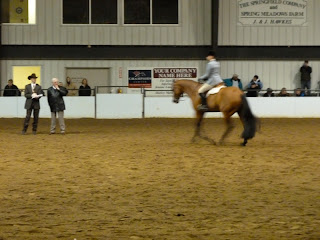English Equitation is a common class at many horse shows. It isn't seen too much in the model world, but it would be a very easy to setup! Here is the stock type version that is used at most open shows.
From the AQHA rulebook, Equitation is described as follows:
“Hunt seat equitation on the flat is an evaluation based on the ability of a rider to perform various maneuvers in harmony with his/her horse. The communication between horse and rider through subtle cues and aids should not be obvious. Equitation is judged on the rider and his/her effect on the horse. Hunt seat equitation on the flat provides a base for a natural progression to over fence classes. The poll should be level with, or slightly above the withers, to allow proper impulsion behind. The head should not be carried behind the vertical, giving the appearance of intimidation, or be excessively nosed out, giving a resistant appearance.”
Considering Equitation classes are waited heavely on the rider, it is crucial to have a doll in your set up! But other than that, all you need is a few cones and possibly a judge! Along with some english tack and a horse, of course!
To begin with, every Equitation class has a pattern. Like showmanship, the pattern is posted ahead of time to give the exhibitors a chance to memorize it. The one from the show looked like this:
To start the class, riders line their horses up ‘tails to the rail’. In a way, equitation is very similar to showmanship. Once everyone is in the arena and ready to go, the judge nods to signal the first rider to start the pattern. Then the rider waiting at the cone can start their pattern.
For this pattern, the rider started by sitting the trot from cone A to cone B.
Then at cone B, the horse should pick up the lead lead and canter a circle.
Once the circle is complete, the horse should drop to a trot and the rider should post on the right diagonal.
Next, halt at cone C and back up.
After the rein back, the rider looks at the judge, who then dismisses her with a nod.
Once all the patterns are complete, the rest of the class is treated like normal english pleasure. Everyone walks, trots, and canters on the rail. They may only go one direction or both.
Here is a video of a few of the better patterns:
Patterns may vary greatly from show to show. This is a very common type of pattern, usually used at open shows. At higher levels, patterns might include leg yeilds, flying changes, serpentines, etc.
If you have any questions, feel free to ask!





























No comments:
Post a Comment